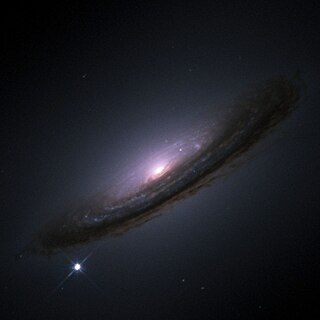
A supernova is a powerful and luminous explosion of a star. A supernova occurs during the last evolutionary stages of a massive star, or when a white dwarf is triggered into runaway nuclear fusion. The original object, called the progenitor, either collapses to a neutron star or black hole, or is completely destroyed to form a diffuse nebula. The peak optical luminosity of a supernova can be comparable to that of an entire galaxy before fading over several weeks or months.

Messier 74 is a large spiral galaxy in the equatorial constellation Pisces. It is about 32 million light-years away from Earth. The galaxy contains two clearly defined spiral arms and is therefore used as an archetypal example of a grand design spiral galaxy. The galaxy's low surface brightness makes it the most difficult Messier object for amateur astronomers to observe. Its relatively large angular size and the galaxy's face-on orientation make it an ideal object for professional astronomers who want to study spiral arm structure and spiral density waves. It is estimated that M74 hosts about 100 billion stars.
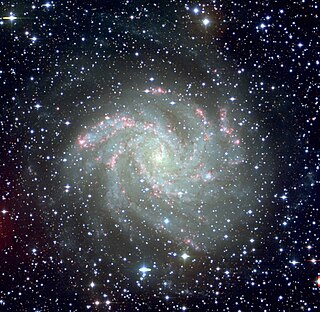
NGC 6946, sometimes referred to as the Fireworks Galaxy, is a face-on intermediate spiral galaxy with a small bright nucleus, whose location in the sky straddles the boundary between the northern constellations of Cepheus and Cygnus. Its distance from Earth is about 25.2 million light-years or 7.72 megaparsecs, similar to the distance of M101 in the constellation Ursa Major. Both were once considered to be part of the Local Group, but are now known to be among the dozen bright spiral galaxies near the Milky Way but beyond the confines of the Local Group. NGC 6946 lies within the Virgo Supercluster.

A Type Ia supernova is a type of supernova that occurs in binary systems in which one of the stars is a white dwarf. The other star can be anything from a giant star to an even smaller white dwarf.

SN 1994D was a Type Ia supernova event in the outskirts of galaxy NGC 4526. It was offset by 9.0″ west and 7.8″ south of the galaxy center and positioned near a prominent dust lane. It was caused by the explosion of a white dwarf star composed of carbon and oxygen. This event was discovered on March 7, 1994 by R. R. Treffers and associates using the automated 30-inch telescope at Leuschner Observatory. It reached peak visual brightness two weeks later on March 22. Modelling of the light curve indicates the explosion would have been visible around March 3-4. A possible detection of helium in the spectrum was made by W. P. S. Meikle and associates in 1996. A mass of 0.014 to 0.03 M☉ in helium would be needed to produce this feature.
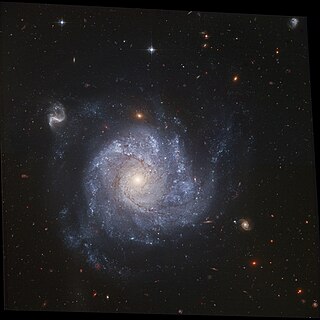
NGC 1309 is a spiral galaxy located approximately 120 million light-years away, appearing in the constellation Eridanus. It is about 75,000 light-years across, and is about 3/4s the width of the Milky Way. Its shape is classified as SA(s)bc, meaning that it has moderately wound spiral arms and no ring. Bright blue areas of star formation can be seen in the spiral arms, while the yellowish central nucleus contains older-population stars. NGC 1309 is one of over 200 members of the Eridanus Group of galaxies.
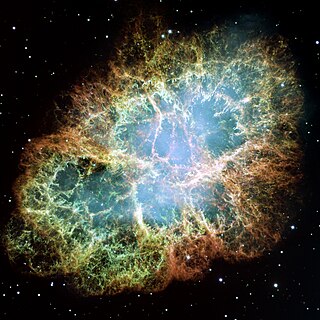
The known history of supernova observation goes back to 1006 AD. All earlier proposals for supernova observations are speculations with many alternatives.
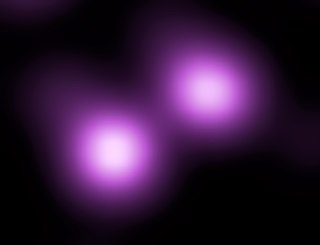
SN 2006gy was an extremely energetic supernova, also referred to as a hypernova, that was discovered on September 18, 2006. It was first observed by Robert Quimby and P. Mondol, and then studied by several teams of astronomers using facilities that included the Chandra, Lick, and Keck Observatories. In May 2007, NASA and several of the astronomers announced the first detailed analyses of the supernova, describing it as the "brightest stellar explosion ever recorded". In October 2007, Quimby announced that SN 2005ap had broken SN 2006gy's record as the brightest-ever recorded supernova, and several subsequent discoveries are brighter still. Time magazine listed the discovery of SN 2006gy as third in its Top 10 Scientific Discoveries for 2007.
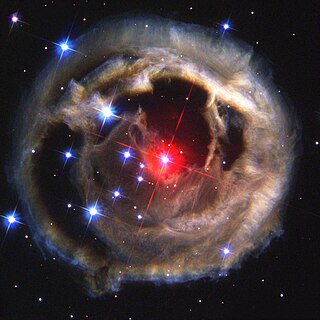
A luminous red nova is a stellar explosion thought to be caused by the merging of two stars. They are characterised by a distinct red colour, and a light curve that fades slowly with resurgent brightness in the infrared. Luminous red novae are not related to standard novae, which are explosions that occur on the surface of white dwarf stars.

Nicholas B. Suntzeff is an American astronomer and cosmologist. He is a university distinguished professor and holds the Mitchell/Heep/Munnerlyn Chair of Observational Astronomy in the Department of Physics & Astronomy at Texas A&M University where he is director of the Astronomy Program. He is an observational astronomer specializing in cosmology, supernovae, stellar populations, and astronomical instrumentation. With Brian Schmidt he founded the High-z Supernova Search Team, which was honored with the Nobel Prize in Physics in 2011 to Schmidt and Adam Riess.
SN 1990U was a type Ic supernova event in the nucleus of the galaxy NGC 7479. It was discovered July 27, 1990 by the Berkeley Automated Supernova Search after reaching magnitude 16±0.5. Initially this was classified as a Type Ib supernova, but the weakness of the neutral helium absorption lines led to a reclassification.

NGC 6118 is a grand design spiral galaxy located 83 million light-years away in the constellation Serpens. It was discovered on 14 April 1785 by German-British astronomer William Herschel.
SN 2002cx is a peculiar type Ia supernova. It was discovered in May 2002 by a team of researchers from LBL. It behaved differently from normal type Ia supernovae, and differently from several other previously observed peculiar type Ia supernovae including SN 1991T and SN 1991bg.

NGC 634 is a spiral galaxy, lying at a distance of 217.1 megalight-years away from the Milky Way in the northern constellation of Triangulum. This object was discovered on 26 October 1876 by French astronomer Édouard Stephan. It is inclined by an angle of 82.4° to the line of sight from the Earth, and thus is being viewed nearly edge on.
In astronomy, a calcium-rich supernova is a subclass of supernovae that, in contrast to more well-known traditional supernova classes, are fainter and produce unusually large amounts of calcium. Since their luminosity is located in a gap between that of novae and other supernovae, they are also referred to as "gap" transients. Only around 15 events have been classified as a calcium-rich supernova – a combination of their intrinsic rarity and low luminosity make new discoveries and their subsequent study difficult. This makes calcium-rich supernovae one of the most mysterious supernova subclasses currently known.
SN 1961i was a supernova that was discovered in June 1961 in the Messier 61 galaxy, by Milton L. Humason at the Palomar Observatory, the brightest of 16 supernovae found at Palomar that year. Although it was originally considered by Fritz Zwicky to be the prototype of a type III supernova, subsequent researchers have classified it as a type II supernova.

NGC 1325 is a flocculent spiral galaxy situated in the constellation of Eridanus. Located about 75 million light years away, it is a member of the Eridanus cluster of galaxies, a cluster of about 200 galaxies. It was discovered by William Herschel on 19 December 1799.

NGC 2906 is a spiral galaxy located in the constellation Leo. It is located at a distance of circa 120 million light years from Earth, which, given its apparent dimensions, means that NGC 2906 is about 75,000 light years across. It was discovered by William Herschel on December 28, 1785.
Maryam Modjaz is a German-American astrophysicist who is a professor and Director of Equity and Inclusion at the New York University. Her research considers the death of massive stars. She was awarded an Alexander von Humboldt Foundation Fellowship in 2018, which she spent at the Max Planck Institute for Astronomy.












